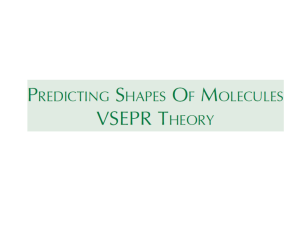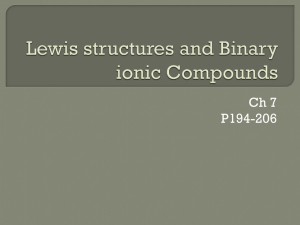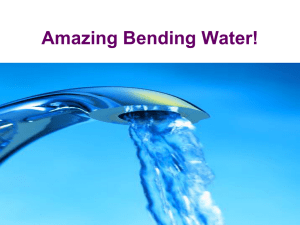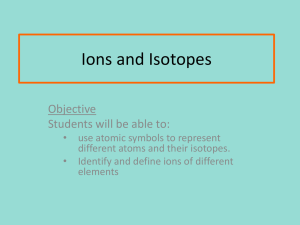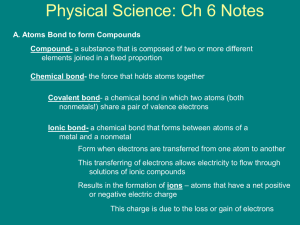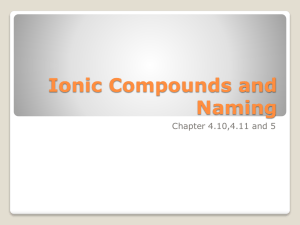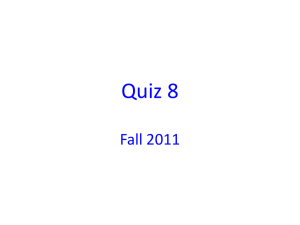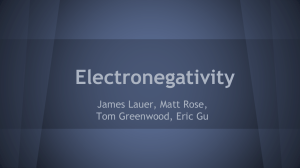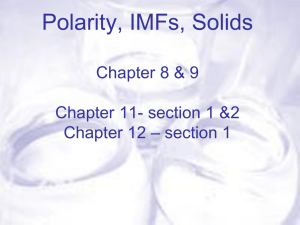ChemI Bonding
advertisement
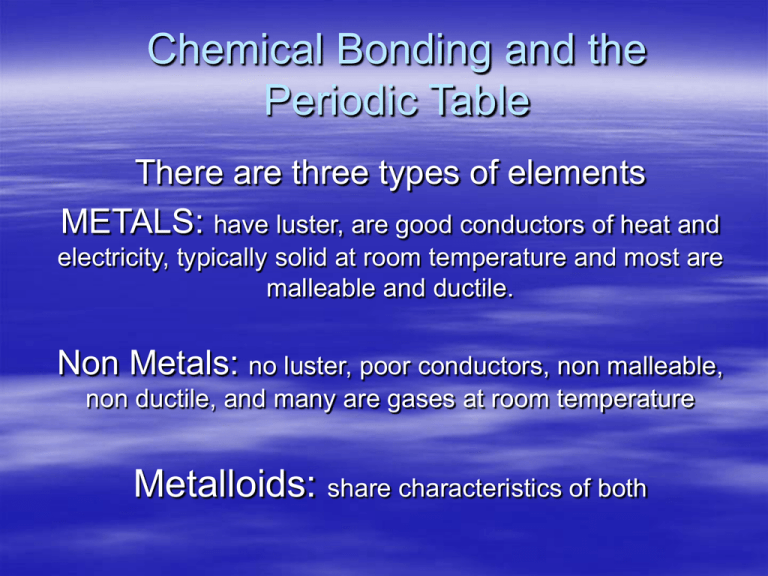
Chemical Bonding and the Periodic Table There are three types of elements METALS: have luster, are good conductors of heat and electricity, typically solid at room temperature and most are malleable and ductile. Non Metals: no luster, poor conductors, non malleable, non ductile, and many are gases at room temperature Metalloids: share characteristics of both Remember these areas! Covalent Bonding Elements share electrons in order to fill valance shells. S and P block elements follow Octet rule Typically occur between non-metals, metalloids, and a mixture of both Hydrogen behaves as a non metal even though its on the left side of the periodic table Lewis Dot Structures A Lewis dot structure is like a simplified electron energy level model. The Lewis structure contains the element symbol with dots representing electrons. The only electrons shown are those on the outer energy level or valence electrons. The electrons are placed around the element symbol, one at a time, clockwise or counterclockwise, and then grouped in pairs as more electrons are added. Covalent Bonds in Lewis dot diagrams Two electrons between atoms form a covalent bond Bonds are drawn as lines and count for two electrons around that atom Extra electrons then pair up around the more “electronegative” element, the element more to the right on the periodic table. Ideal configurations result in eight electrons around each atom *hydrogen needs only two electrons since its part of the K shell Water: first do the dot diagrams for each atom Make Molecule Extra electrons not in a bond are called “lone pairs” These lone pairs result in one side of the water molecule to have a more negative charge than the other This is called a polar covalent molecule The Water Molecule Molecule Instability If molecule forms that has more than two lone pairs it will react readily to get rid of the extra electrons Where is the problem with hydrogen peroxide-draw in the lone pairs Polar vs Non Polar Polar molecules have a positive and negative part Will mix with other polar substances, + on one molecule will be attracted to – on another molecule Non polar molecules share all electrons equally. No + or – end Non polar will not mix with polar because of lack of electrostatic attraction! Non Polar Molecules Have a symmetric structure Compounds with a high percentage of carbon bonded to hydrogen are non polar Do NOT mix with water Covalent Compound Characteristics Do Not Conduct Electricity Low Boiling and Melting Points due to strong intramolecular forces but weak intermolecular forces Polar compounds will have higher melting/boiling points than non polar compounds Usually liquids or gases When solid, will be brittle and good insulators Ionic Compounds Occur between metals and non-metals Electron transfer occurs, one substance loses while another gains electrons CATION=Substance that loses electrons now has more protons than electrons thus net positive charge ANION=Substance that gains electrons and now has more electrons than protons thus a net negative charge Metals form Cations, Non Metals form Anions, metalloids can be either Transition Metals can form more than one possible Cation Ionic compounds are held together by electrostatic forces. Opposites Attract! Characteristics of Ionic Compounds Conduct electricity well when dissolved in water “electrolytes”. Solids do not conduct well High melting and boiling points due to strong electrostatic intermolecular forces Mostly solids. Solids will have different shapes depending on cation to anion ratio in molecule Different Crystal Structures come from cation/anion rations CaF2 Fluorite Polyatomic Ions Common Polyatomic Ions Polyatomic Ions Stable covalent molecules (non-metals) that form with an unbalance of protons and electrons, hence they are ions Have their own chemical and physical properties like other compounds Form electrically neutral ionic compounds with metals When these compounds dissolve, only the metal and the polyatomic ion as a whole separate, the polyatomic ion’s atoms stay together Making Ionic Compounds with Polyatomic Ions Combine sodium with the ion hydroxide ‘OH’ Na forms a +1 cation Hydroxide OH is a -1 anion Combine to form neutral compound, charge on cation must be cancelled by charge on anion NaOH Try it with Calcium……….. Calcium Hydroxide Calcium forms a +2 cation Hydroxide is -1 anion so need two of them for every one calcium Ca(OH)2 Parentheses work just like in math, subscript goes with whatever is in the parentheses Compounds with Polyatomic Ions
